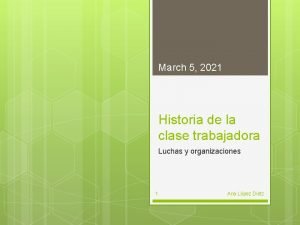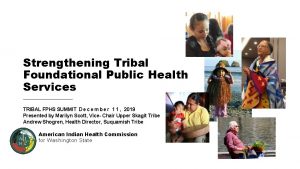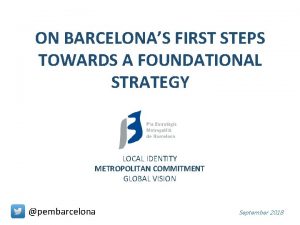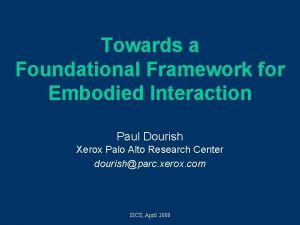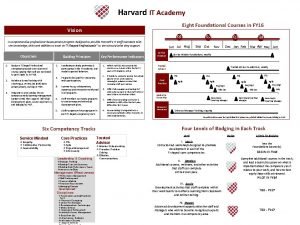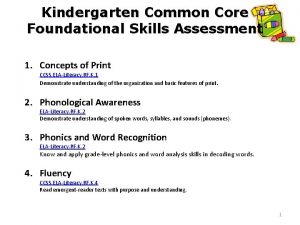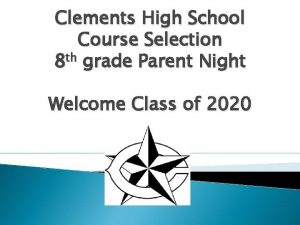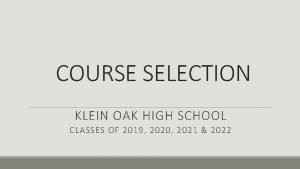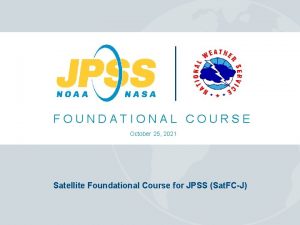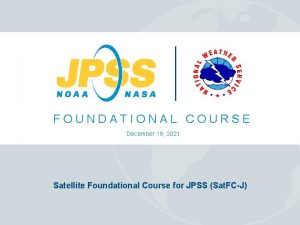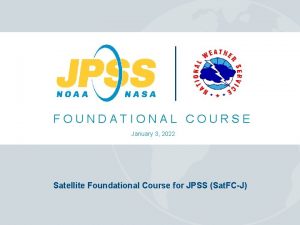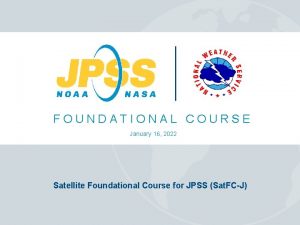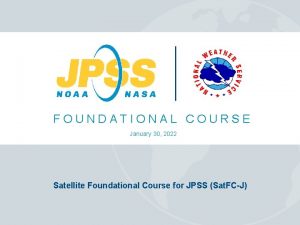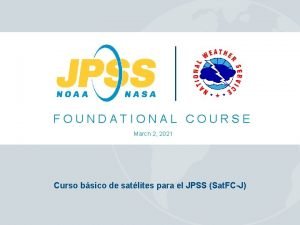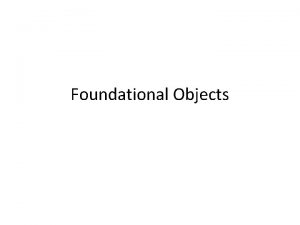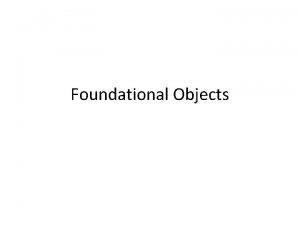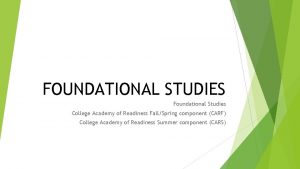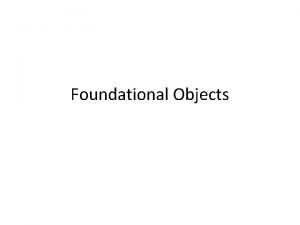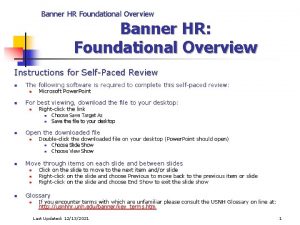FOUNDATIONAL COURSE March 8 2021 Satellite Foundational Course


















- Slides: 18

FOUNDATIONAL COURSE March 8, 2021 Satellite Foundational Course for JPSS (Sat. FC-J)

MICROWAVE FOUNDATIONAL COURSE Introduction to Microwave Remote Sensing (with a focus on passive sensing)

1. Provide a general introduction to microwave remote sensing that covers imagers vs. sounders, passive vs. active sensors, and microwave frequency channels 2. Understand how microwave remote sensing complements visible and infrared observation and why this is important 3. Briefly examine how absorption/emission, transmission, and scattering influences the usage and interpretation of microwave measurements INITIATIVES APPLICATIONS CONSTELLATION MICROWAVE Learning Objectives FOUNDATIONAL COURSE | 3

APPLICATIONS CONSTELLATION MICROWAVE Product Preview AMSR 2 Sea. Total Surface Soil Moisture Temperature 2017 -09 -23 ATMS MIRS Precipitable Water 2017 -09 -23 ATMS AMSR 2 MIRS Cloud Wind Rain Liquid Speed Rate Water 2017 -09 -23 § A combination of channels are used to create products • total precipitable water • cloud liquid water • rain rate • wind speed • sea surface temperature INITIATIVES • soil moisture NOAA Mi. RS Products: https: //www. star. nesdis. noaa. gov/jpss/EDRs/products_Mi. RS. php FOUNDATIONAL COURSE | 4

Imager § Horizontal detail § 2 -D view Sounder vs Ex: Advanced Microwave Scanning Radiometer-2 (AMSR-2) vs • 7 channels § Vertical detail § “ 3 -D view” § Provides atmospheric profiles Ex: Advanced Technology Microwave Sounder (ATMS) • 22 channels INITIATIVES APPLICATIONS CONSTELLATION MICROWAVE Types of Microwave Instrumentation FOUNDATIONAL COURSE | 5

Passive • Detects natural emission • Used to measure atmospheric profiles • Radiometers and scanners Active • Provides source of radiation and measures backscattered signal • Influence of other sources complicates interpretation INITIATIVES APPLICATIONS CONSTELLATION MICROWAVE Types of Microwave Sensors FOUNDATIONAL COURSE | 6

g endin desc ding INITIATIVES g APPLICATIONS Suomi National Polar–orbiting Partnership (S-NPP) Orbit Tracks n asce CONSTELLATION MICROWAVE Global Coverage 2 x Daily FOUNDATIONAL COURSE | 7

Microwavelength = 0. 1 -30 cm (300 -1 GHz) Increasing: wavelength, sensor footprint Decreasing: frequency, energy 109 Hz = 1 GHz INITIATIVES APPLICATIONS CONSTELLATION MICROWAVE Electromagnetic Spectrum Additional Resource: Sat. FC-G Basic Principles of Radiation https: //www. meted. ucar. edu/training_module. php? id=1239#. WEc. PZfkr. KUl FOUNDATIONAL COURSE | 8

INITIATIVES Vertical Transmittance to Space APPLICATIONS CONSTELLATION MICROWAVE Microwave Spectrum In general: § Window regions are used to sense surface features § Absorption regions are used to derive temperature and moisture profiles Frequency (GHz) source: COMET FOUNDATIONAL COURSE | 9

INITIATIVES APPLICATIONS CONSTELLATION MICROWAVE Measured Brightness Temperature absorption / emission Absorption Regions Clear Sky or Non-Precipitating Clouds transmission • Temperature profiles • Moisture profiles Precipitating Clouds • Ice particles scattering Window Regions Clear Sky or Non-Precipitating Clouds • • • Land surface temp. Sea ice Soil moisture Cloud droplets (<. 1 mm radius) • Ocean winds Precipitating Clouds • Precipitation type • Rain rate FOUNDATIONAL COURSE | 10

INITIATIVES APPLICATIONS CONSTELLATION MICROWAVE Window View of Surface Features ATMS Ch 2 (31. 4 GHz) 2017 -9 -23 1806 Z Ocean § Low emissivity (~0. 5) provides a uniform, cold background Land § Variable emissivity (~0. 95) °C -125 150 -105 170 -85 190 -65 210 -45 230 -25 250 -5 270 15 290 K FOUNDATIONAL COURSE | 11

INITIATIVES APPLICATIONS CONSTELLATION MICROWAVE “Dirty” Window View ATMS Ch 16 (88. 2 GHz) 2017 -9 -23 1806 Z § Non-precipitating clouds are transparent § Total atmospheric column can be observed °C -125 150 -105 170 -85 190 -65 210 -45 230 -25 250 -5 270 15 290 K FOUNDATIONAL COURSE | 12

INITIATIVES APPLICATIONS CONSTELLATION MICROWAVE Water Vapor Absorption ATMS Ch 20 (183. 3 GHz) 2017 -9 -23 1806 Z § Used to sense the moisture at various levels in the atmosphere °C -125 150 -105 170 -85 190 -65 210 -45 230 -25 250 -5 270 15 290 K FOUNDATIONAL COURSE | 13

INITIATIVES APPLICATIONS CONSTELLATION MICROWAVE Oxygen Absorption ATMS Ch 10 (57. 3 GHz) 2017 -9 -23 1806 Z § Used to sense the temperature at various levels in the atmosphere Small temperature variation across the image (~300 mb level) °C -125 150 -105 170 -85 190 -65 210 -45 230 -25 250 -5 270 15 290 K FOUNDATIONAL COURSE | 14

§ Displayed in AWIPS as NUCAPS soundings § NUCAPS = NOAA Unique Combined Atmospheric Processing System INITIATIVES APPLICATIONS CONSTELLATION MICROWAVE Vertical Profiles FOUNDATIONAL COURSE | 15

§ Microwave and infrared sounders have huge impacts in forecasts through assimilation into numerical weather prediction models 500 h. Pa geopotential height anomaly correlation 12 -month running mean INITIATIVES APPLICATIONS % CONSTELLATION MICROWAVE Assimilation into Numerical Models 1981 2017 FOUNDATIONAL COURSE | 16

INITIATIVES APPLICATIONS CONSTELLATION MICROWAVE Advantages and Limitations Microwave Advantages • Non-precipitating clouds are transparent • Precipitation rate estimation, ocean winds, soil moisture • Atmospheric temperature and moisture profiles • Blended with other high resolution measurements in products and assimilated into models Microwave Limitations • Longer wavelength limits spatial resolution • Variations in surface emissivity complicate interpretation • Infrequent observations: 2 x daily passes per satellite FOUNDATIONAL COURSE | 17

MICROWAVE § Satellite Meteorology: An Introduction (Kidder and Vonder Haar 1995) INITIATIVES APPLICATIONS § Microwave Remote Sensing: Overview (2 nd Edition) https: //www. meted. ucar. edu/training_module. php? id=979 CONSTELLATION Resources § A First Course in Atmospheric Radiation, 2 nd Ed. (Petty 2006) § Basics of Visible and Infrared Remote Sensing https: //www. meted. ucar. edu/training_module. php? id=1096#. WEm. PA_kr. KUk § Sat. FC-G Basic Principles of Radiation https: //www. meted. ucar. edu/training_module. php? id=1239#. WEc. PZfkr. KUl Questions? Email: Bernie. Connell@colostate. edu Narrator: Bernie Connell Editors: Erin Dagg, Bernie Connell Other Contributors: John Forsythe FOUNDATIONAL COURSE | 18
 March march dabrowski
March march dabrowski Current events quiz
Current events quiz March 5 2021
March 5 2021 Foundational marketing
Foundational marketing Foundational skills definition
Foundational skills definition Foundational marketing
Foundational marketing Foundational economy
Foundational economy Foundational public health services
Foundational public health services Fcs amerigroup
Fcs amerigroup Foundational strategy
Foundational strategy Foundational marketing
Foundational marketing Foundational framework meaning
Foundational framework meaning Harvard it academy
Harvard it academy Foundational skills assessment
Foundational skills assessment Saeta refresher course 2021
Saeta refresher course 2021 Clements high school course selection 2020-2021
Clements high school course selection 2020-2021 Solanco powerschool
Solanco powerschool Promise2purpose.net
Promise2purpose.net Course number and title
Course number and title


